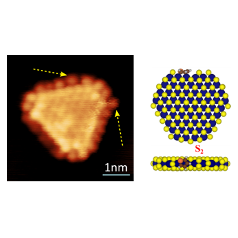Room to react: new results with potential to help produce cleaner fuel
New results, with implications for catalysis used for cleaning up crude and bio oils, show that a reactant molecule can generate its own larger active site, when it is adsorbed onto certain vacancy positions on MoS2 nanoparticles. The finding has been published in Nature Communications by the group of Jeppe V. Lauritsen at iNANO, Aarhus University.

Bonding of a molecule onto a nanoparticle’s surface is a key step in heterogeneous catalysis, but in some cases, the molecule is too big to fit onto the site at which it should react. This was thought to be the case for adsorption of heteroatom-bearing molecules, present in crude or bio oils, when they undergo hydrotreating on MoS2 catalyst nanoparticles. Hydrotreating serves in the fuel industry to remove unwanted N, S or O-containing chemical compounds in crude or bio oil, before it is upgrade into a clean fuel. In a new paper in Nature Communications, the group of Jeppe V. Lauritsen has worked with the theoretical modelling group of Manos Mavrikakis, University of Wisconsin-Madison to show that some reactant molecules can adsorb on vacancy sites on a MoS2 nanoparticle, despite being too big to fit in such a site.
Potential to help develop better catalysts for producing cleaner fuel
By using atomic resolution microscopy images of thiophene molecules interacting with the surface of a MoS2 nanoparticle performed and computational modelling, it was possible to show that the molecule favorably pushes aside neighboring S atoms at some vacancy sites to generate its own larger adsorption site on two Mo atoms. The mechanism is new and explains why MoS2 catalysts can clean up much larger molecules present in crude oil than predicted by models. The new insight can potentially help develop better catalysts for conversion of crude and renewable bio oil into ultra-clean diesel and jet fuel.
The experimental work was performed by Dr. Norberto Salazar and Dr. Jonathan Rodríguez-Fernández at Interdisciplinary Nanoscience Center (iNANO) and the project was funded by the Independent Research Fund Denmark (FTP project, HYDECAT) and VILLUM Fonden.
Contact
Associate Professor Jeppe Vang Lauritsen
Interdisciplinary Nanoscience Center (iNANO)
Aarhus University
Telephone: (+45) 87156728
Email: jvang@inano.au.dk
